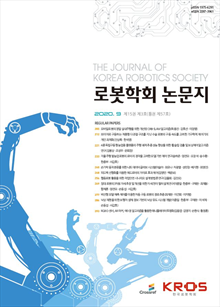간행물
로봇학회논문지 KCI 등재 The Journal of Korea Robotics Society

- 발행기관 한국로봇학회
- 자료유형 학술지
- 간기 계간
- ISSN 1975-6291 (Print)2287-3961 (Online)
- 수록기간 2006 ~ 2020
- 주제분류 공학 > 제어계측공학 공학 분류의 다른 간행물
- 십진분류KDC 559DDC 629
권호리스트/논문검색
제10권 제3호 (통권 제37호) (2015년 8월) 6건
1.
2015.08
서비스 종료(열람 제한)
This paper presents a modified task structure of coupled-constraints consensus based bundle algorithm especially to resolve the cooperative transportation problem. The cooperative transportation mission has various types of constraints. A modified framework to generate activities and subtasks to solve time and task constraints of the transportation mission by using coupled-constraints consensus based bundle algorithm is suggested. In this paper modifications on task structure, reward function and arrival time calculation are suggested to handle the constraints of cooperative transportation mission.
2.
2015.08
서비스 종료(열람 제한)
This paper proposed a method of cooperative control of three mobile robots for carrying an object placed on a floor together. Each robot moves to the object independently from its location to a pre-designated location for grasping the object stably. After grasping the common object, the coordination among the robots has been achieved by a master-slave mode. That is, a trajectory planning has been done for the master robot and the distances form the master robot to the two slave robots have been kept constant during the carrying operation. The localization for mobile robots has been implemented using the encoder data and inverse kinematics since the whole system does not have the slippage as much as a single mobile robot. Before the carrying operation, the lifting operations are implemented using the manipulators attached on the top of the mobile robots cooperatively. The real cooperative lifting and carrying operations are implanted to show the feasibility of the master-slave mode control based on the kinematics using the mobile manipulators developed for this research.
3.
2015.08
서비스 종료(열람 제한)
In order to contain as much information as possible in a single image, a wide FOV(Field-Of-View) imaging system is required. The catadioptric imaging system with hyperbolic cylinder mirror can acquire over 180 degree horizontal FOV realtime panorama image by using a conventional camera. Because the hyperbolic cylinder mirror has a curved surface in horizontal axis, the original image acquired from the imaging system has the geometrical distortion, which requires the image processing algorithm for reconstruction. In this paper, the image reconstruction algorithms for two cases are studied: (1) to obtain an image with uniform angular resolution and (2) to obtain horizontally rectilinear image. The image acquisition model of the hyperbolic cylinder mirror imaging system is analyzed by the geometrical optics and the image reconstruction algorithms are proposed based on the image acquisition model. To show the validity of the proposed algorithms, experiments are carried out and presented in this paper. The experimental results show that the reconstructed images have a uniform angular resolution and a rectilinear form in horizontal axis, which are natural to human.
4.
2015.08
서비스 종료(열람 제한)
Conventional path tracking methods designed for two-wheeled differential drive robots are not suitable for omni-directional robots. In this study, we present a controller which can accomplish more accurate path tracking and orientation correction by exploiting the unconstrained movement capability of omni-directional robots. The proposed controller is proven to be stable using a Lyapunov stability criterion. Various experiments in real environments show that performance of path tracking and orientation correction has improved in the proposed controller.
5.
2015.08
서비스 종료(열람 제한)
This paper describes the development of a hand module of NREX (National Rehabilitation Center Robotic Exoskeleton) designed to assist individuals with sustained neurological impairments such as stroke and spinal cord injuries. To construct a simple and lightweight hand module, the robotic hand adopts a mechanism driven by a motor and moved by two four-bar linkages. The motor facilitates the flexion-extension movements of the thumb and the other four fingers simultaneously. Thus, an individual using the robotic hand module can effectively grip and release objects related to daily life activities. The robotic hand module has been designed to cover the range of motion with respect to its link distance. This hand module can be used in therapeutic rehabilitation as well as for daily life assistance. In addition, this hand module can either be mounted on an NREX or used as a standalone module.
6.
2015.08
서비스 종료(열람 제한)
A telerobot offers a more engaging and enjoyable interaction with people at a distance by communicating via audio, video, expressive gestures, body pose and proxemics. To provide its potential benefits at a reasonable cost, this paper presents a telepresence robot system for video communication which can deliver speaker’s head motion through its display stanchion. Head gestures such as nodding and head-shaking can give crucial information during conversation. We also can assume a speaker’s eye-gaze, which is known as one of the key non-verbal signals for interaction, from his/her head pose. In order to develop an efficient head tracking method, a 3D cylinder-like head model is employed and the Harris corner detector is combined with the Lucas-Kanade optical flow that is known to be suitable for extracting 3D motion information of the model. Especially, a skin color-based face detection algorithm is proposed to achieve robust performance upon variant directions while maintaining reasonable computational cost. The performance of the proposed head tracking algorithm is verified through the experiments using BU's standard data sets. A design of robot platform is also described as well as the design of supporting systems such as video transmission and robot control interfaces.

